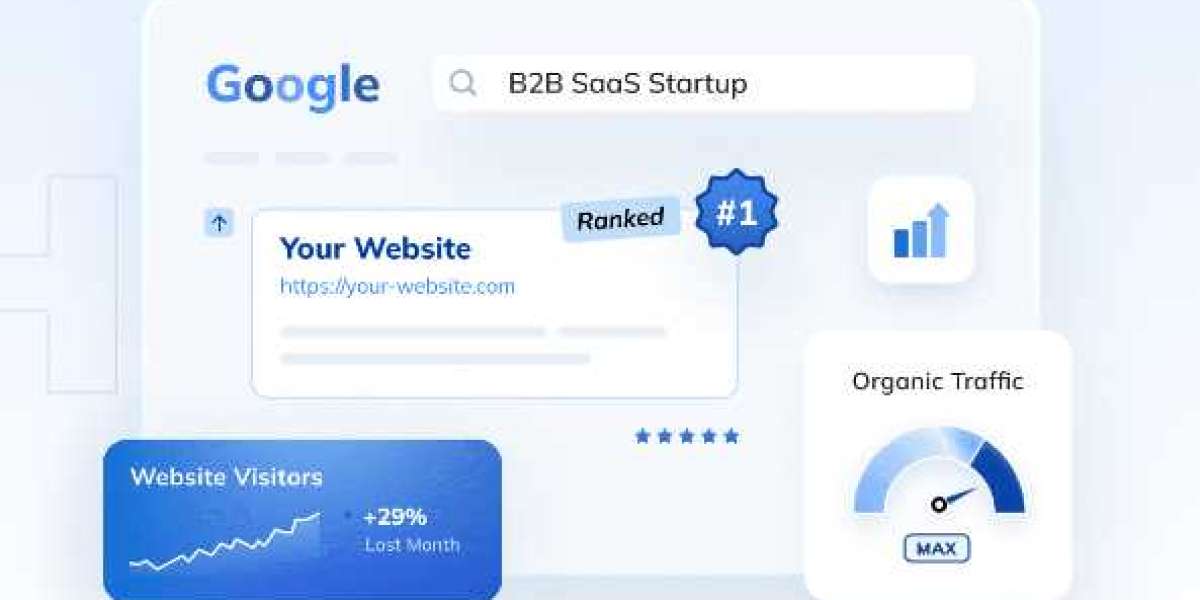In the competitive landscape of B2B SaaS (Software as a Service), having a robust SEO (Search Engine Optimization) strategy is crucial for driving organic traffic, generating leads, and ultimately achieving business growth. However, to ensure that your SEO efforts are paying off, it is essential to evaluate the performance of your B2B SaaS SEO agency regularly. This evaluation is not just about checking the rankings or traffic but involves a comprehensive analysis of various metrics and key performance indicators (KPIs) that reflect the effectiveness of your SEO strategy. This article will guide you through the key metrics and KPIs you should focus on to assess the performance of your B2B SaaS SEO agency effectively.
1. Understanding the Role of SEO in B2B SaaS
Before diving into the metrics and KPIs, it's important to understand why SEO is crucial for B2B SaaS companies. SEO helps B2B SaaS businesses enhance their online visibility, attract targeted traffic, and generate high-quality leads. Unlike B2C companies, B2B SaaS businesses often deal with longer sales cycles and more complex buying processes, which makes SEO even more important in driving qualified leads and nurturing them through the sales funnel.
2. Setting Clear Objectives and KPIs
Effective evaluation starts with clear objectives. These objectives should align with your overall business goals and SEO strategy. Typical SEO objectives for B2B SaaS companies include increasing organic traffic, improving search engine rankings, generating high-quality leads, and enhancing brand awareness.
Once you have set clear objectives, you need to identify the KPIs that will help you measure the success of your SEO efforts. Here are some key metrics and KPIs to consider:
3. Organic Traffic
Metric: Organic Traffic
Description: Organic traffic refers to the number of visitors who land on your website through search engine results rather than paid advertisements. It's a fundamental metric for assessing the effectiveness of your SEO strategy.
How to Measure:
- Google Analytics: Use Google Analytics to track the number of organic visitors and analyze trends over time.
- Search Console: Google Search Console provides insights into organic search performance, including impressions, clicks, and average position.
Why It Matters: An increase in organic traffic indicates that your SEO efforts are driving more visitors to your website. However, it's important to look beyond just the numbers and analyze the quality of the traffic, such as engagement and conversion rates.
4. Keyword Rankings
Metric: Keyword Rankings
Description: Keyword rankings track where your website appears in search engine results pages (SERPs) for specific keywords or phrases. It helps you understand how well your website is optimized for targeted keywords.
How to Measure:
- Rank Tracking Tools: Use tools like SEMrush, Ahrefs, or Moz to monitor keyword rankings and track changes over time.
- Google Search Console: Provides data on your website's average position for various keywords.
Why It Matters: Higher keyword rankings typically lead to increased visibility and organic traffic. Regularly monitoring keyword rankings helps you identify which keywords are performing well and which need optimization.
5. Conversion Rate
Metric: Conversion Rate
Description: Conversion rate measures the percentage of visitors who take a desired action on your website, such as filling out a lead form, signing up for a demo, or making a purchase.
How to Measure:
- Google Analytics: Set up goals and track conversion rates based on specific actions taken by visitors.
- CRM Systems: Use customer relationship management (CRM) systems to track leads and conversions.
Why It Matters: High organic traffic is valuable only if it leads to conversions. A low conversion rate may indicate issues with your website’s user experience, content, or lead generation forms.
6. Backlink Profile
Metric: Backlink Profile
Description: The backlink profile refers to the quantity and quality of external websites linking to your site. Backlinks are crucial for SEO as they signal to search engines that your site is authoritative and trustworthy.
How to Measure:
- Backlink Analysis Tools: Use tools like Ahrefs, Majestic, or Moz to analyze your backlink profile, including the number of backlinks, referring domains, and the quality of the links.
- Google Search Console: Provides information on the websites linking to your site.
Why It Matters: A strong backlink profile can significantly improve your search engine rankings. However, focus on acquiring high-quality, relevant backlinks rather than just increasing quantity.
7. Domain Authority
Metric: Domain Authority (DA)
Description: Domain Authority is a metric developed by Moz that predicts how well a website will rank on search engines. It’s a score between 0 and 100, with higher scores indicating a greater likelihood of ranking well.
How to Measure:
- Moz Tool: Use Moz’s Domain Authority tool to check your website’s DA score and compare it with competitors.
- SEO Tools: Many other SEO tools provide similar metrics for evaluating domain authority.
Why It Matters: A higher Domain Authority indicates a stronger website, which can lead to better search engine rankings. It’s a good indicator of overall SEO health.
8. Click-Through Rate (CTR)
Metric: Click-Through Rate (CTR)
Description: CTR measures the percentage of users who click on your website’s link after seeing it in the search results. It’s an indicator of how effective your titles and meta descriptions are at attracting clicks.
How to Measure:
- Google Search Console: Provides CTR data for your website’s pages and queries.
- SEO Tools: Many SEO tools offer CTR metrics and insights.
Why It Matters: A higher CTR means that your meta titles and descriptions are compelling and relevant to users. Improving CTR can drive more organic traffic to your site.
9. Bounce Rate
Metric: Bounce Rate
Description: Bounce rate measures the percentage of visitors who leave your website after viewing only one page. It indicates how engaging and relevant your content is to visitors.
How to Measure:
- Google Analytics: Provides bounce rate data for different pages and segments of your website.
Why It Matters: A high bounce rate may suggest that visitors are not finding what they are looking for or that your landing pages need improvement. Reducing bounce rate can improve user experience and engagement.
10. Page Load Speed
Metric: Page Load Speed
Description: Page load speed refers to how quickly your website’s pages load for users. It’s a critical factor for user experience and SEO.
How to Measure:
- Google PageSpeed Insights: Provides performance scores and recommendations for improving page load speed.
- GTmetrix: Offers detailed analysis of page speed and suggestions for optimization.
Why It Matters: Faster load times lead to better user experience and lower bounce rates. Page speed is also a ranking factor for search engines, making it essential for SEO performance.
11. Organic Search Visibility
Metric: Organic Search Visibility
Description: Organic search visibility measures how visible your website is in search engine results for relevant keywords. It’s an aggregate indicator of your SEO performance.
How to Measure:
- SEO Tools: Tools like SEMrush, Ahrefs, and Moz offer visibility metrics that track your site’s presence in search results.
Why It Matters: Higher search visibility means that your website is ranking well for a range of keywords, leading to increased organic traffic and brand awareness.
12. Engagement Metrics
Metric: Engagement Metrics
Description: Engagement metrics include metrics such as average session duration, pages per session, and social shares. These metrics help assess how users interact with your content.
How to Measure:
- Google Analytics: Provides data on session duration, pages per session, and other engagement metrics.
- Social Media Analytics: Track social shares and interactions through platforms’ analytics tools.
Why It Matters: High engagement levels indicate that your content is valuable and relevant to users. Improving engagement can lead to better SEO performance and higher conversion rates.
13. Lead Generation Metrics
Metric: Lead Generation Metrics
Description: Lead generation metrics track the effectiveness of your SEO efforts in generating leads. This includes metrics such as the number of leads generated, lead quality, and lead conversion rates.
How to Measure:
- CRM Systems: Track leads and their sources through CRM systems.
- Google Analytics: Use goals and events to measure lead generation.
Why It Matters: Generating high-quality leads is a primary goal for B2B SaaS companies. Effective SEO should contribute to increasing the number and quality of leads.
14. ROI from SEO Efforts
Metric: Return on Investment (ROI)
Description: ROI measures the financial return you receive from your SEO investment compared to the cost of SEO services. It helps assess the overall value and effectiveness of your SEO strategy.
How to Measure:
- Cost Tracking: Calculate the total cost of SEO services and compare it with the revenue generated from organic traffic and leads.
- Analytics and CRM Data: Use data from Google Analytics and CRM systems to measure the impact of SEO on revenue and leads.
Why It Matters: ROI provides a clear picture of whether your SEO investment is delivering value. A positive ROI indicates that your SEO efforts are successful and contributing to business growth.
15. Evaluating Agency Performance
To effectively evaluate your B2B SaaS SEO agency, consider the following steps:
Regular Reporting: Ensure that your agency provides regular reports on the key metrics and KPIs mentioned above. Review these reports to assess performance and identify areas for improvement.
Benchmarking: Compare your SEO performance with industry benchmarks and competitors to gauge how well your agency is performing relative to others in your sector.
Communication: Maintain open communication with your agency to discuss performance, challenges, and strategies. Regular meetings and updates can help address issues and align goals.
Transparency: Ensure that your agency is transparent about their methods, strategies, and results. This helps build trust and ensures that you are aware of how your SEO investment is being utilized.
Feedback and Adjustments: Provide feedback to your agency based on the performance metrics and work together to make necessary adjustments to the SEO strategy.
Conclusion
Evaluating the performance of your B2B SaaS SEO agency involves a thorough analysis of various metrics and KPIs. By focusing on key indicators such as organic traffic, keyword rankings, conversion rates, backlink profile, and ROI, you can gain valuable insights into the effectiveness of your SEO efforts. Regularly monitoring and assessing these metrics will help you ensure that your SEO strategy is driving growth and delivering the desired results for your B2B SaaS business.








